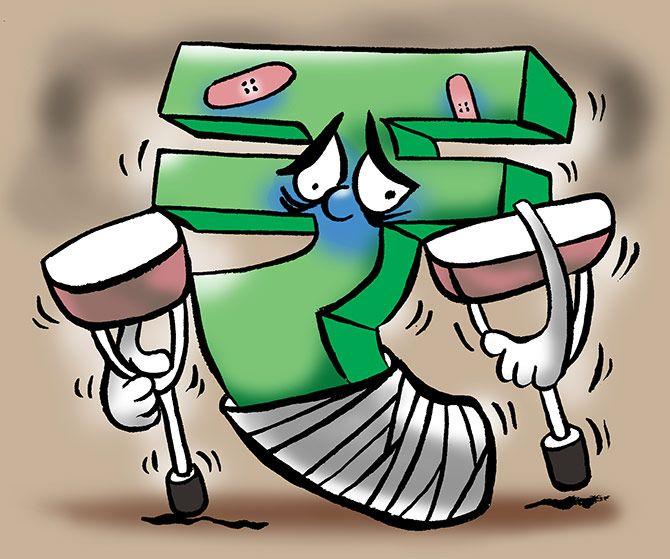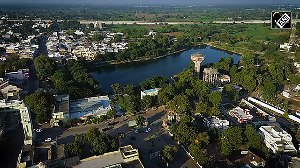Investors are anxious over the US-China trade tension, a sharp devaluation in yuan and uncertainty over Kashmir issue.
Illustration: Uttam Ghosh/Rediff.com

The rupee on Monday crashed by 113 paise -- the biggest single-day drop in past six years -- to close at a five-month low of 70.73 due to heavy capital outflows by investors anxious over the US-China trade tension, a sharp devaluation in yuan and uncertainty over Kashmir issue.
This was the third straight session of fall for the rupee, during which it lost a massive 194 paise.
The US-China trade-related concerns weighed on the investor community and kept the pressure on the Indian rupee, forex traders said.
"India's rupee tumbled the most since December triggered by depreciating Yuan.
“Chinese Yuan weakened beyond 7 per dollar for the first time since 2008, signalling a new phase in the trade war between US and China," said V K Sharma, head PCG & Capital Markets Strategy, HDFC Securities.
Rahul Gupta, currency research head, Emkay Global Financial Services said following the global trade turmoil between US-China and political imbalance in Kashmir led USD/INR to end on a weak note.
Many forex traders would now likely rush to protect their positions in emerging markets currencies and get out as China seems more than willing to let its currency crumble in an effort to shore up trade volumes and negate the pricing impact from US tariffs, said Rajesh Cheruvu, chief investment officer, Validus Wealth.
"The ramifications for China would, of course, be the capital markets outflows from the country.
“The INR should also mirror some of the same weakness and FPIs may continue their dumping spree of Indian assets resulting in a bleak near term outlook for the INR," he projected.
In a highly volatile trade, the rupee opened at 70.20 at the interbank forex market and touched a low of 70.74 and a high of 70.18 against the American currency.
The currency finally settled at 70.73 against the US dollar -- a level not seen since March 1 --, down 113 paise or 1.62 per cent over its previous closing price.
This is the highest single-day fall for the rupee since August 2013.
Traders said the near term focus will be on the RBI's monetary policy meeting scheduled to announce outcome on August 7th.
The market has already priced in 25 bps cut in interest rate amid lower core CPI and persistent economic slowdown.
"Meanwhile, this week is the RBI policy. Widely, RBI is expected to cut rates further by 25 bps and continue to hold the accommodative stance which will weigh on rupee," Gupta said.
Forex traders said, besides the US-China trade-related concerns, Home Minister Amit Shah moving a resolution in the Rajya Sabha that all clauses of Article 370 will not be applicable to Jammu and Kashmir kept the pressure on the Indian rupee.
The government on Monday moved a bill proposing bifurcation of the state of Jammu and Kashmir into two union territories -- Jammu and Kashmir division and Ladakh.
However, easing crude oil prices and weakening of the American currency vis-a-vis other currencies overseas supported the local unit to some extent.
Brent crude futures, the global oil benchmark, fell 1.18 per cent to $ 61.16 per barrel.
The dollar index, which gauges the greenback's strength against a basket of six currencies, fell 0.39 per cent to 97.69.
Foreign institutional investors (FIIs) remained net sellers in the capital markets, pulling out Rs 2,016 crore on Monday, as per provisional data.
The 10-year government bond yield was at 6.39 per cent on Monday.
On the domestic market front, after cracking over 700 points in day trade, the 30-share index pared losses to close at 36,699.84, still down by 418.38 points, or 1.13 per cent.
It hit a low of 36,416.79 and a high of 36,844.05.
Meanwhile, Financial Benchmark India Private Ltd (FBIL) set the reference rate for the rupee/dollar at 69.3981 and for rupee/euro at 76.9366.
The reference rate for rupee/British pound was fixed at 84.0892 and for rupee/100 Japanese yen at 64.82.










